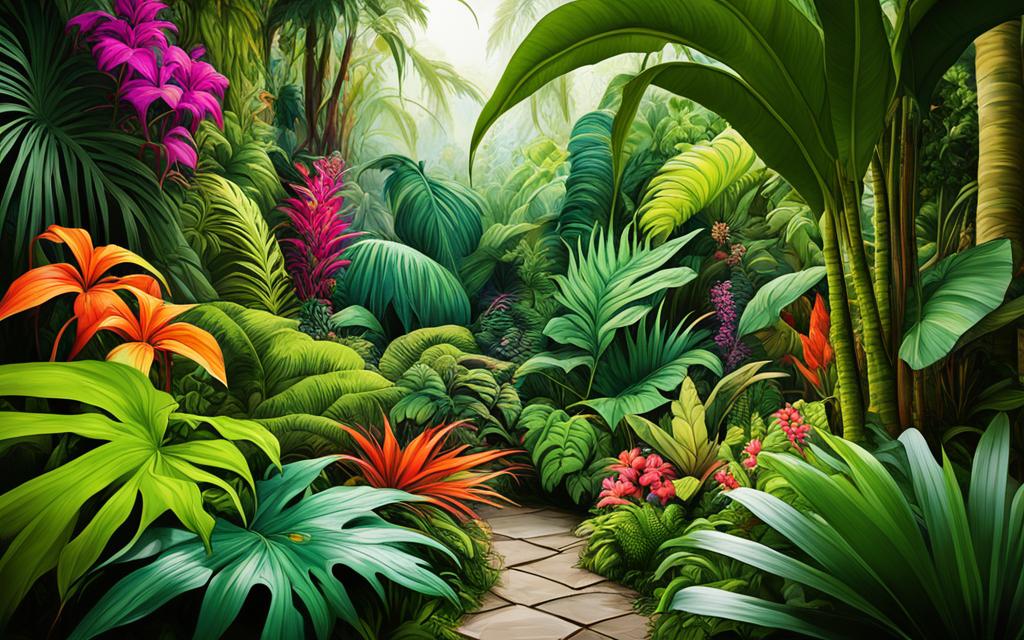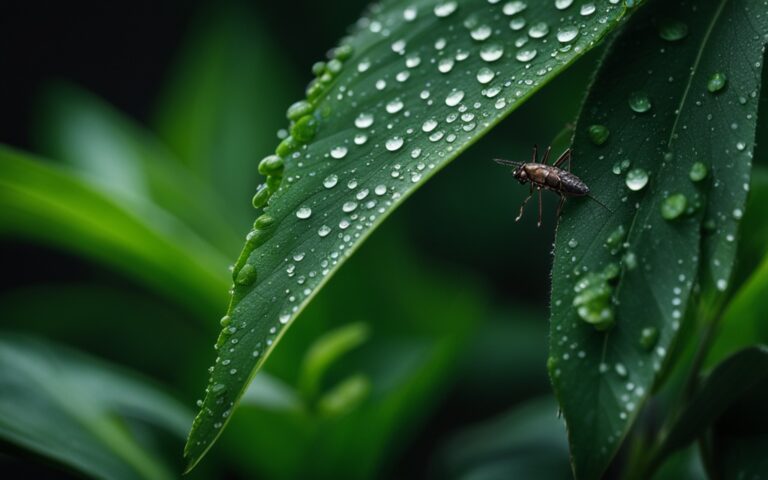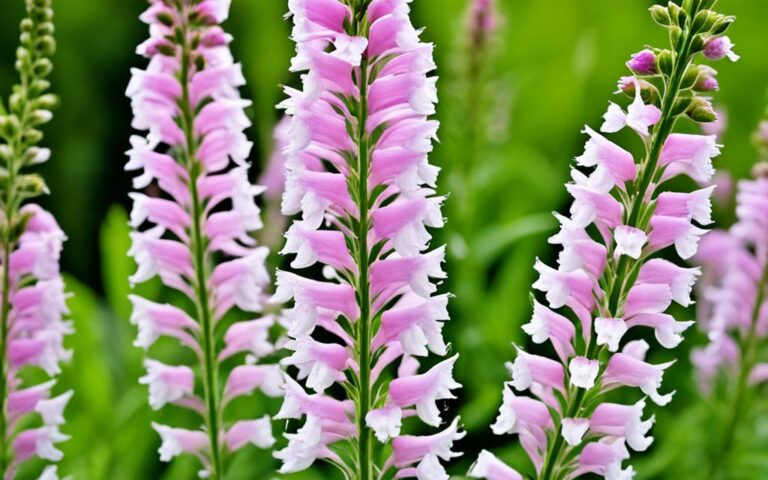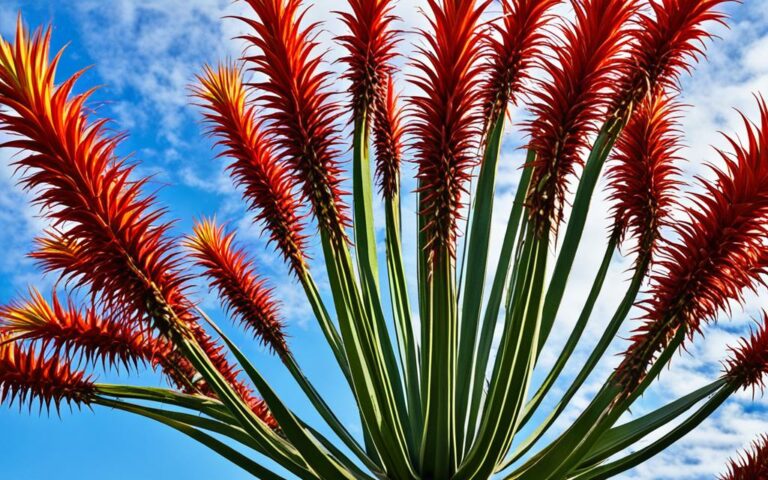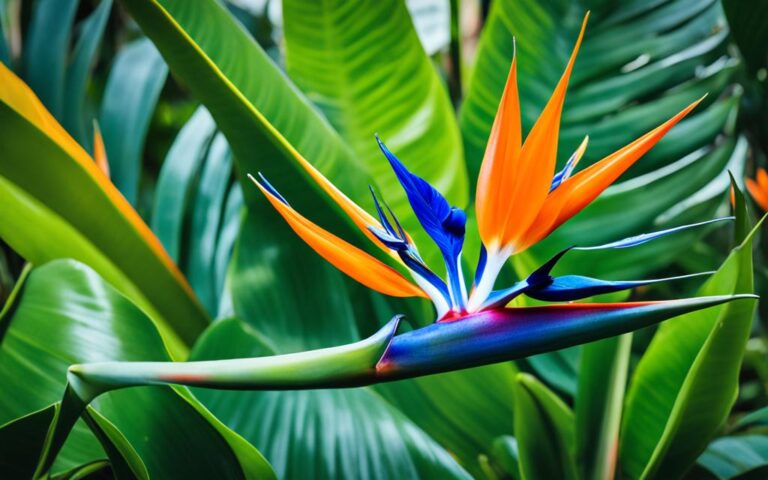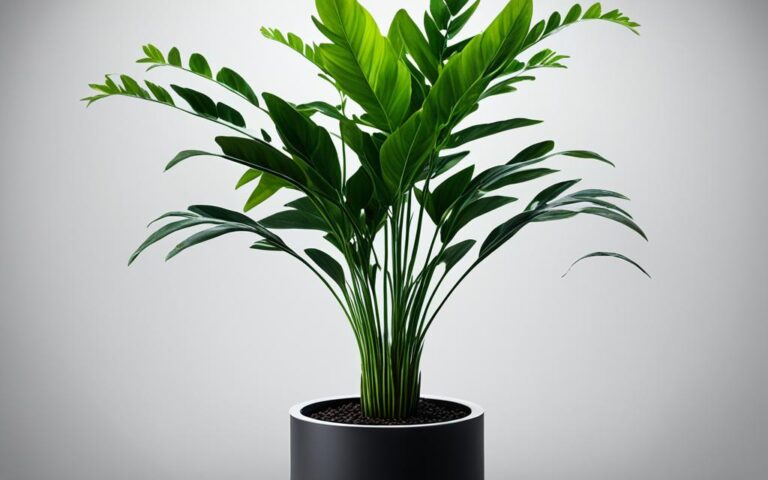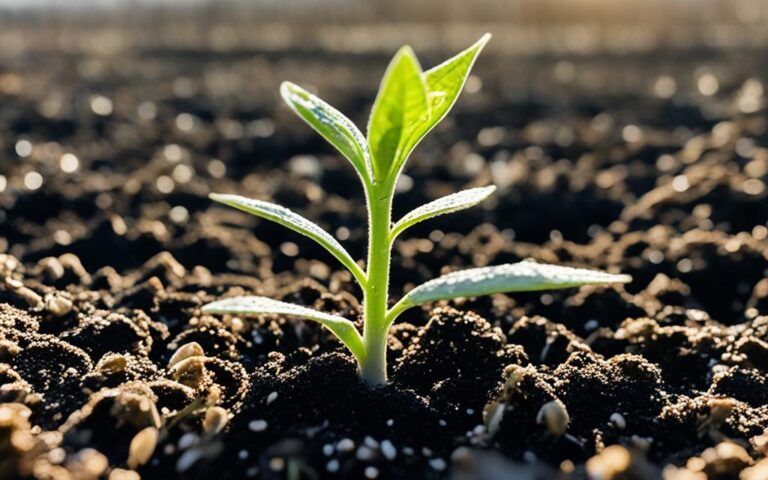Discover Exotic Tropical Plants for Your Home
Did you know the average American home has over 6 houseplants? These plants bring a touch of the tropics into our lives. They make our homes feel calm and green. From tall palm trees to tiny orchids, there’s a wide variety of plants to choose from.
Adding tropical plants to your home is easy and rewarding. This guide will show you how to bring the beauty of the tropics indoors. Whether you love plants or are just starting, you’ll find the perfect tropical plants to make your space feel like a peaceful oasis.
Key Takeaways
- Discover the diverse world of exotic tropical plants to enhance your home decor
- Learn about the benefits of indoor tropical flora, from air purification to stress reduction
- Explore a wide range of tropical plant varieties, from palms and orchids to fragrant houseplants
- Uncover tips for selecting the right tropical plants based on your space and lifestyle
- Dive into the captivating world of tropical plant care and maintenance
Embrace the Tropical Paradise Indoors
Step into an exotic houseplant oasis and feel the lush, restful vibe of a tropical oasis. These plants not only make your decor pop with beauty and lush greenery. They also clean the air and help reduce stress. Learn how to add a variety of indoor jungle plants to your space for a peaceful, rainforest-inspired decor.
Introducing the Lush World of Exotic Tropical Plants
Popular tropical plants for inside include pothos, peace lilies, snake plants, and zz plants. These plants are tough and can grow in different light, perfect for adding a tropical paradise feel to any room. They bring beauty and calm to your home with their unique looks.
Transforming Your Living Space into a Serene Oasis
- Incorporate Hawaiian plants for a pop of color, adding vibrant flowers and shiny leaves to your space.
- Use hanging planters, terrariums, big floor plants, and vertical gardens to make your exotic houseplants stand out.
- Pick plants that fit the lighting, humidity, and size of each room, like living rooms, bedrooms, or bathrooms.
- Choose the right tropical plant combinations to match your style, from modern to bohemian chic.
Being around indoor jungle plants can lower stress, lift your mood, and increase creativity and productivity. Bring the rainforest-inspired decor of the tropics into your home for a calming, refreshing effect.
Choosing the Right Tropical Plant
When picking a tropical plant for your home, think about the space you have, your lifestyle, and the plant’s needs. Big areas can hold big palms, while small spots are perfect for succulents and Snake Plants. Make sure the plant likes the light, temperature, and humidity of your home. If you have pets, pick plants that are safe for them to make a pet-friendly tropical spot.
Assessing Space and Plant Size
The size of your space is key when choosing a tropical plant. Big rooms can fit tall plants like Hibiscus moschuetos or Hostas. These plants can grow wide or tall. For small areas, go for Alocasia plants or Lantanas. They are smaller but still beautiful.
Considering Environmental Factors
Tropical plants love warm, humid places. Make sure your home can offer these conditions. They need bright, indirect sunlight and food during the growing season. Think about the climate and specific needs of the plant you want. If you have pets, pick plants that are safe for them to keep your tropical spot pet-friendly.
| Tropical Plant | Size Range | Climate Zones |
|---|---|---|
| Hibiscus moschuetos | Up to 8 inches in width | Zones 5-9 |
| Hostas | 6 inches to 6 feet wide | Zones 3-9 |
| Cannas | 18 inches to over 6 feet tall | Zones 8-10 |
| Alocasia | Couple of inches to 3 feet | Zones 9-11 |
| Lantanas | 2 to 6 feet tall, 3 to 10 feet wide | Zones 9-11 |
| Sweet Potato Vines | 6 inches to 3-1/2 feet tall, 1 to 3 feet wide | Zone 11 or as annuals |
| Bougainvillea | 2 to 30 feet tall and wide | Zones 9-12 |
Low-Maintenance Tropical Plant Options
Adding a touch of tropical flair to your home doesn’t have to be hard. There are many easy-care tropical plants and beginner-friendly houseplants that are low-maintenance. They can bring the lush feel of the tropics to your space with little effort.
The Pothos is a popular choice for those new to plant care. It’s known for being hardy and adaptable to different lighting conditions. Its glossy, heart-shaped leaves make it a great choice for filling out spaces.
The Spider Plant is another great option for beginners. It’s known for its cascading, spiderette-like offshoots. This plant is resilient and can quickly recover from neglect, making it perfect for those who might forget to water their plants.
| Plant | Height | Light Requirements | Water Needs |
|---|---|---|---|
| Pothos | 3-5 feet | Bright, indirect light | Allow soil to dry out between waterings |
| Spider Plant | 12-18 inches | Bright, indirect light | Moderately moist soil |
| ZZ Plant | 2-3 feet | Low to medium light | Infrequent watering |
The ZZ Plant is a top choice for those who want low-maintenance foliage. It has thick, waxy leaves and can tolerate low light. This makes it a great option for both seasoned plant parents and beginners. These easy-care tropical plants and beginner-friendly houseplants are sure to add beauty to your home with minimal effort.
Keeping Your Tropical Plants Happy
It’s key to give your tropical plants the right care to keep them healthy and bright. Make sure to water them regularly, but not too much. Too much water can harm your plants.
Watering Practices
In winter, tropical houseplants slow down and need less water. They should not be fed from late September to early March to prevent root damage. Succulents like cactuses and jade plants should be watered only when their leaves dry out.
Check if your plant needs water by sticking your finger into the soil an inch deep. If it feels dry, it’s time to water. Overwatering is the main reason tropical plants die, so check the soil every day.
Nutritional Needs
Feed your plants with a balanced fertilizer when they’re growing. With so many tropical plants out there, each has its own fertilization needs. Talk to a local florist or horticulturist to get the right nutrients for your plants.
Creating a humid environment is also key for your plants. Just putting plants on wet pebbles or misting them won’t help much. Try grouping plants together or using indoor fountains to increase humidity and fight dry air.
By following these tips, you can keep your indoor tropical plants looking great all year.
The Majesty of Tropical Palms
Bring the grandeur of the tropics into your home with indoor palm trees. The Majesty Palm and Areca Palm add elegance and lush fronds. They make a stunning centerpiece for your living spaces.
The Majesty Palm is a slow-growing houseplant perfect for adding dramatic foliage to your home. It can fill corners, line up as a screen, or divide a room. But, place it in shaded areas, not sunny spots, as it prefers low light.
| Majesty Palm Care Requirements | Ideal Conditions |
|---|---|
| Light Needs | Medium to High Light |
| Watering | Evenly Moist Potting Mix |
| Fertilization | General-Purpose Houseplant Fertilizer |
| Pests | Spider Mites (Maintain Humidity) |
| Companion Plants | Money Tree, Nerve Plant |
Majesty Palms are great for purifying the air and are easy to grow. They’re perfect for creating a lush indoor palm trees oasis or adding a statement piece to your space. These palms will captivate and transform your surroundings.
“The Majesty Palm is a truly impressive addition to any home, with its dramatic foliage and architectural elegance.”
Exotic Blooms: Orchids and More
Discover the magic of tropical plants like the orchid. These plants come in many colors and have beautiful, detailed flowers. They make any room look special. But, taking good care of them is key to their happiness.
Orchids need the right water and environment to do well. This includes Moth Orchids, which are popular. Knowing what they need will help your orchids bloom beautifully.
Orchid Care Essentials
Orchids have lovely flowers in white, pink, and purple. To keep them happy, follow these tips:
- Give them bright, indirect sunlight. They like light but not too much.
- Water them often, but don’t overdo it. Too much water can harm the roots.
- Keep the air around them moist. Orchids love a humid environment.
- Feed them with a special orchid food to help them grow strong.
With proper care, your orchids will bloom beautifully for a long time.
| Orchid Variety | Bloom Color | Bloom Duration |
|---|---|---|
| Moth Orchid (Phalaenopsis) | White, Pink, Purple | 2-3 Months |
| Dendrobium Orchid | White, Yellow, Pink | 4-6 Weeks |
| Cattleya Orchid | Purple, Lavender, White | 2-3 Weeks |
Explore the world of tropical plants and let orchids make your home a peaceful place.
“Orchids, with their delicate and symmetrical blooms, are the epitome of tropical elegance. Bringing these exotic beauties into your home is a surefire way to add a touch of the tropics to your indoor sanctuary.”
Tropical Plant for Beginners
Starting with tropical plants can seem tough, especially for beginners. But, there are many easy tropical plants perfect for those new to houseplants. These plants are low-maintenance and still look great.
The Pothos is a top pick for beginners. It’s also called “devil’s ivy” because it grows well without much care. It can handle less water and light. The Snake Plant is another great choice. It can live in many places and cleans the air too.
The ZZ Plant is great for beginners. It’s almost impossible to kill because it can survive with little water and light. It’s perfect for busy people or those new to tropical plants.
Dracaena, Chinese Evergreen, and Peace Lily are also easy to care for. They bring tropical looks to your home with little work. These plants fit well in many indoor spaces.
| Tropical Plant | Mature Size (Height x Width) | Light Requirements | Watering Needs |
|---|---|---|---|
| Pothos | 3-10 feet x 1-3 feet | Low to bright, indirect light | Allow soil to dry out between waterings |
| Snake Plant | 1-4 feet x 1-2 feet | Low to bright, indirect light | Water when soil is dry |
| ZZ Plant | 2-4 feet x 2-4 feet | Low to bright, indirect light | Water when soil is dry |
| Dracaena | 2-8 feet x 2-4 feet | Bright, indirect light | Water when top inch of soil is dry |
| Chinese Evergreen | 1-3 feet x 1-2 feet | Low to bright, indirect light | Keep soil consistently moist |
| Peace Lily | 1-4 feet x 1-4 feet | Low to bright, indirect light | Water when soil is slightly dry |
Choosing easy-to-grow tropical plants, houseplants for beginners, and low-maintenance foliage plants lets you enjoy tropical beauty easily. These plants are great for starting your indoor gardening journey.
Bringing the Rainforest Home
Bring the magic of the tropics into your home with tropical plant varieties. Plants like the Alocasia and Philodendron can turn any room into a lush, rainforest-inspired paradise. These tropical plants not only make your space look beautiful but also love the warm, humid conditions they need to thrive.
Alocasia and Philodendron Varieties
The Alocasia, also known as the “Elephant Ear” plant, is a standout with its large, shiny leaves. These tropical plant varieties come in many colors and patterns, from deep greens to purples. On the other hand, Philodendrons have heart-shaped leaves that flow beautifully from hanging baskets or shelves.
Both Alocasia and Philodendron love warm, humid places, making them perfect for your home. With the right care, these tropical plants will make your space feel like a peaceful rainforest oasis.
| Tropical Plant Variety | Leaf Shape | Mature Size | Light Needs |
|---|---|---|---|
| Alocasia | Large, arrow-shaped | Up to 6 feet tall | Partial to full shade |
| Philodendron | Heart-shaped, trailing | Varies by variety | Partial to full shade |
“Tropical plants are a gateway to a lush, verdant world that can transform any indoor space into a serene oasis.”
Tropical plant Propagation Methods
Learn how to grow more tropical plants by mastering propagation. Many plants like Pothos and Philodendrons can be grown from cuttings. This lets you make new plants from ones you already have. You can use division and aerial rooting to grow your tropical plant propagation. This way, you can share your tropical plant with others.
Pothos and Monstera plants are great for propagation using plant cuttings. Sansevieria does well with leaf cuttings, but it takes longer to root. Begonias also use leaf cuttings, but it’s a bit harder because of their needs.
You can grow small pups into new plants in two ways. One is by taking the whole plant out and separating the pup with roots. The other is by cutting pups from the mother plant without taking it out. It might take a few weeks for roots to grow in water, so be patient.
- A greenhouse is perfect for some plants because of the bright light, humidity, and air flow it offers.
- Wait for pups to grow big before taking them for propagation. This helps with successful plant division at home.
- Keeping the soil moist is key for expanding your indoor jungle through propagation.
The best time for cutting plants is from May to September. Cut the tips of plants, about as thick as a pencil, and make them 10 to 12 inches long. Put them in one-gallon pots filled with perlite or a good soil mix. Remove lower leaves and flowers/fruits before planting.
Put 3-5 cuttings in a one-gallon pot and they’ll start to root in three to five weeks. Use the mist bench method to keep them moist and humid. Once roots appear, move each plant to its own pot in a place with some sunlight. Let them grow until their roots fill the pot.
Creating an Indoor Jungle
Turn your living areas into a vibrant indoor jungle with a mix of tropical plant arrangements. Try different sizes, textures, and growth patterns to make plant groupings and lush plant displays look amazing. Use tall palms with hanging vines and pair big leaves with small flowers for a jungle look that wows everyone.
Ideal Plant Combinations and Arrangements
Creating a indoor jungle means putting plants of various shapes and sizes together. This adds interest and variety. Having many indoor plants can help lower blood pressure, clean the air, and let you garden all year. Here are some plants to consider for your indoor jungle:
- Pick a big, eye-catching floor plant to make your space feel like a jungle.
- Use hanging plants to make the most of vertical space, especially in small areas.
- Choose plants that do well in low light, small spaces, and have unique leaves.
- Include a mix of foliage types, like Monstera plants with big holes, Anthuriums with thin leaves, and Heart Leaf Philodendrons with hanging vines.
By carefully picking these tropical plant arrangements, you can make your home feel like a lush, jungle oasis. This brings the outdoors inside for you to enjoy.
Benefits of Tropical Plants
Tropical plants are more than just pretty to look at. They bring many benefits that can make you feel better. These plants clean the air by removing bad toxins, making the air cleaner. They also help reduce stress and anxiety, making your space feel calm and refreshing.
Air Purification and Stress Relief
Studies show that tropical plants clean the air by taking out pollutants like VOCs and carbon dioxide. This means better breathing and a fresher space. Plus, being around these plants can make you feel less stressed and more mentally well.
Researchers at the University of Michigan found that memory performance and attention spans improved by 20% after spending an hour with nature.
These plants also keep the air moist, which is good for your skin and breathing. Adding them to your home or office means cleaner air, less stress, and a peaceful, refreshing space.
| Benefits of Tropical Plants | Impact |
|---|---|
| Air Purification | Removes harmful toxins and improves indoor air quality |
| Stress Reduction | Helps lower anxiety and promote a calming atmosphere |
| Natural Humidification | Maintains optimal moisture levels in the air |
| Improved Concentration | Helps people focus better in the home and workplace |
“Being around plants can help people concentrate in the home and workplace. Researchers believe that plants can help with mental fatigue.”
Tropical Plants for Small Spaces
Even with limited space, you can still enjoy the tropical plant trend. Plants like succulents, Snake Plants, and Philodendrons do well in containers and small areas. They let you create a lush, jungle-like feel in even the smallest spaces. Find creative ways to add these plants to your balcony, patio, or indoor spots.
Choosing tropical plants for small spaces is smart because they come in various sizes and growth habits. They range from 30cm to 3m tall, so you can pick the right size for your space. Many prefer partial shade or indirect sunlight, making them great for indoor spots or areas with limited sun.
For those who don’t have much time for gardening, plants like ZZ Plants and Succulents are perfect. They need little water and are easy for beginners. Plus, plants like Monstera Deliciosa and Strelitzia clean the air, making your space healthier.
| Tropical Plant | Ideal Conditions | Key Features |
|---|---|---|
| Monstera Deliciosa | Partial sunlight, weekly watering | Large, dramatic leaves, air-purifying |
| Strelitzia (Bird of Paradise) | Sheltered from wind, full sun or partial shade | Striking orange and blue flowers, air-purifying |
| Philodendron | Medium to bright indirect light, weekly watering | Versatile growth habits (upright, climbing, trailing) |
Whether you have a balcony, patio, or a small indoor area, there are many compact, easy-to-care-for tropical plants. These plants can turn your small space into a lush, vibrant oasis. Embrace the tropical trend and bring a piece of the rainforest to your home.
Caring for Your Tropical Oasis
Looking after your tropical plants needs some extra care, but it’s worth it. Create a routine for pruning, cleaning, and checking on your plants. This helps them grow well and keeps pests away. Also, change your care based on the seasons and your area’s weather to keep your tropical oasis alive and kicking.
Pruning Techniques
It’s key to prune your tropical plants regularly. Cut off dead, damaged, or too-long leaves to help new growth and keep the plant looking good. Always use clean, sharp tools and cut just above a bud or leaf node that faces outward.
Pest Management
Being watchful is crucial for pest control in your tropical plants. Check your plants often for bugs or diseases, like leaves that look bad, webs, or powdery stuff. If you find pests, deal with them fast using safe treatments to keep your plants healthy.
Seasonal Maintenance
Change your plant maintenance plan with the seasons. In the hot months, make sure your tropical plants get enough sun and water. When it gets cooler, cut back on watering and move some plants inside to keep them safe from frost or cold weather.
| Tropical Plant | Sunlight Needs | Watering Requirements |
|---|---|---|
| Tropical Hibiscus | Full sun with partial shade | 1-2 inches of water per day |
| Caladium | Filtered sunlight and shade | Well-draining, organic-rich soil |
| Mandevilla Vine | Full sun | Consistently moist soil |
By sticking to a regular care plan and adjusting it for the seasons, your tropical plants will keep doing well. This turns your living space into a lush, lively oasis.
Conclusion
Let exotic tropical plants change your living spaces into lush, calming places. These plants, from tall palms to tiny orchids, make your home look better and help you breathe easier. They also reduce stress. With the right care, you can bring the beauty of the rainforest into your home all year.
Starting your tropical oasis journey means picking the right plants for your space. Make sure they get the nutrients they need and learn about the many options out there. By following these tips, you’ll make your home a lush indoor sanctuary that’s good for your mind and body.
Let your love for tropical plants turn your living areas into green, refreshing spots. Dive into the world of exotic plants and see how they can improve your health and make your home more welcoming.
